Abstract
Deoxyribonucleic acid (DNA) synthesis was studied in poxvirus-infected cells by measuring 14C-thymidine incorporation into viral and host cell DNA. A complete separation of the two species of DNA was achieved by combining the previously used “Dounce method” with a separation method based on different reannealing properties of viral and vertebrate DNA. Shortly after infection of HeLa cells with poxviruses, a burst of viral DNA synthesis occurred in the cytoplasm, but a rapid inhibition of host-cell DNA synthesis in the nucleus was observed. This inhibition of cellular DNA synthesis was also found if an accumulation of viral DNA was prevented. At high multiplicites, ultraviolet-irradiated virus inhibited host-cell DNA synthesis to the same extent as fully infectious poxvirus. Under the same conditions, heating at 60 C for 15 min caused a decrease in the ability of cowpox virus to inhibit host-cell DNA synthesis, but did not produce the same effect on vaccinia virus strain WR.
Full text
PDF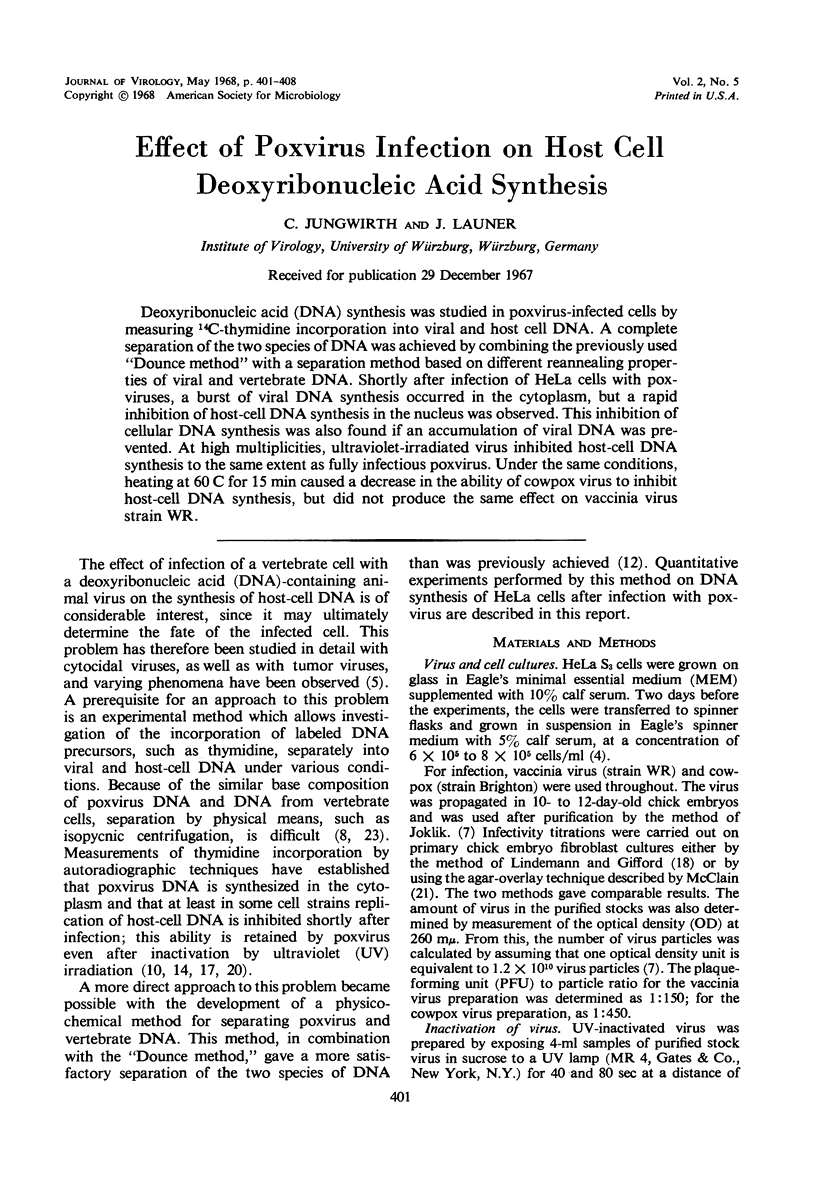
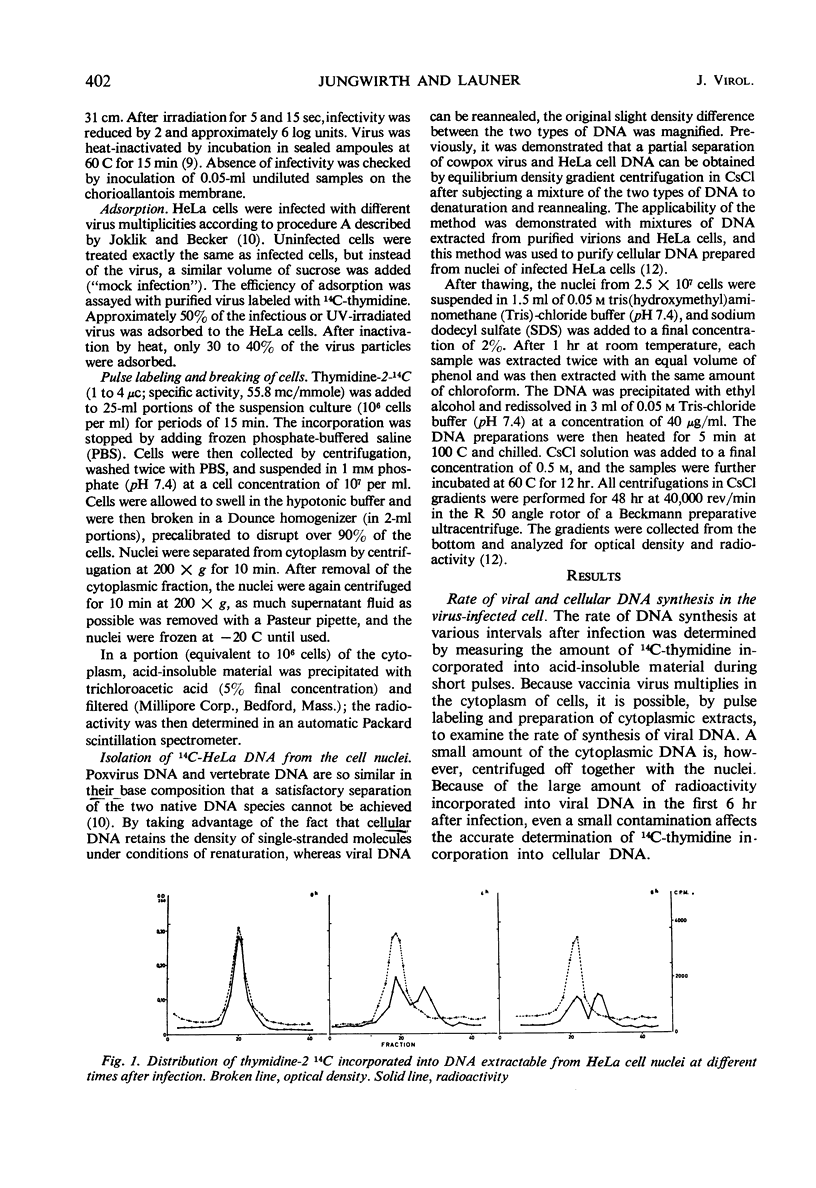

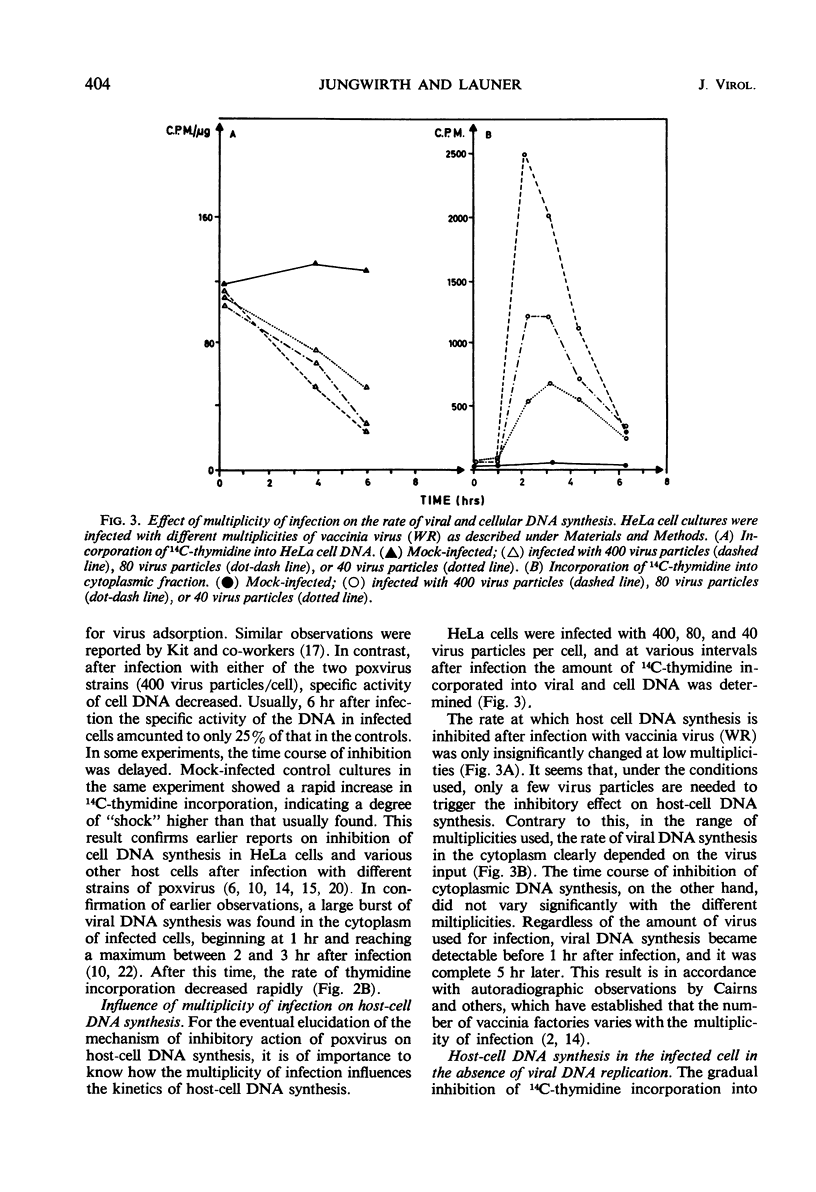
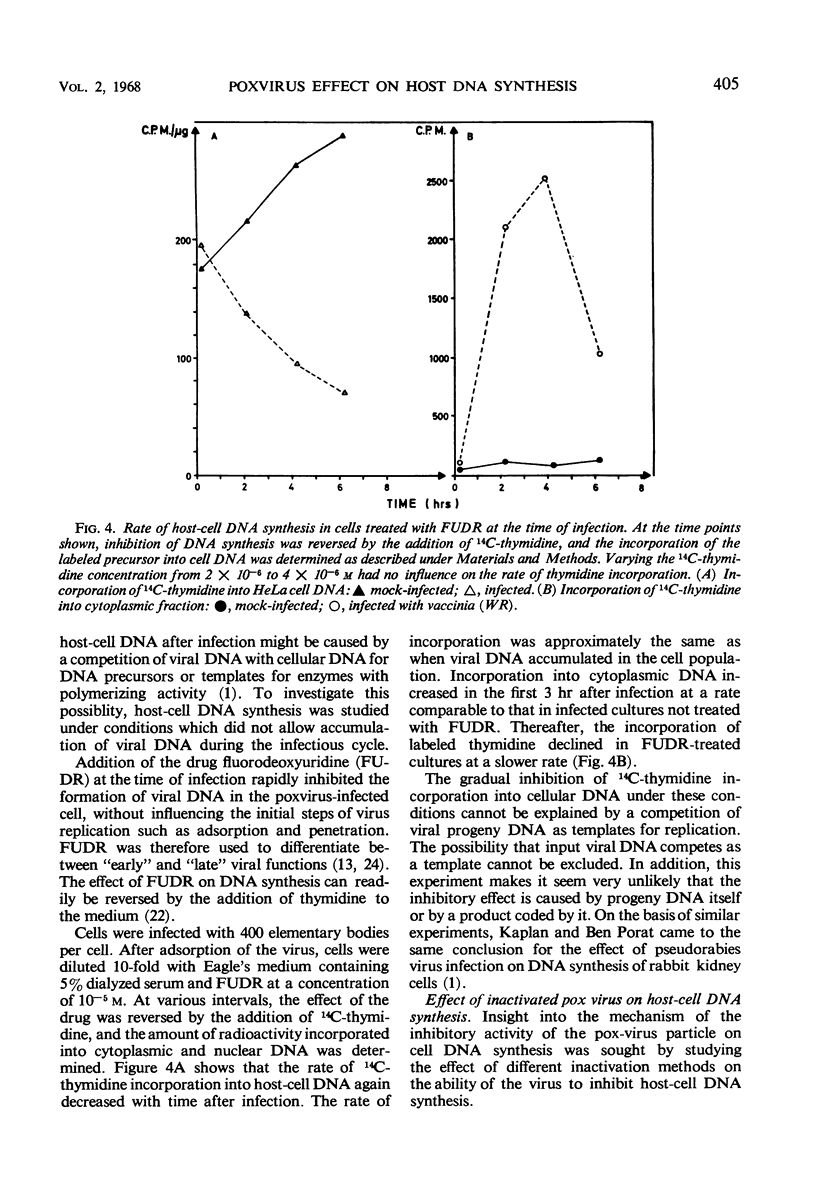


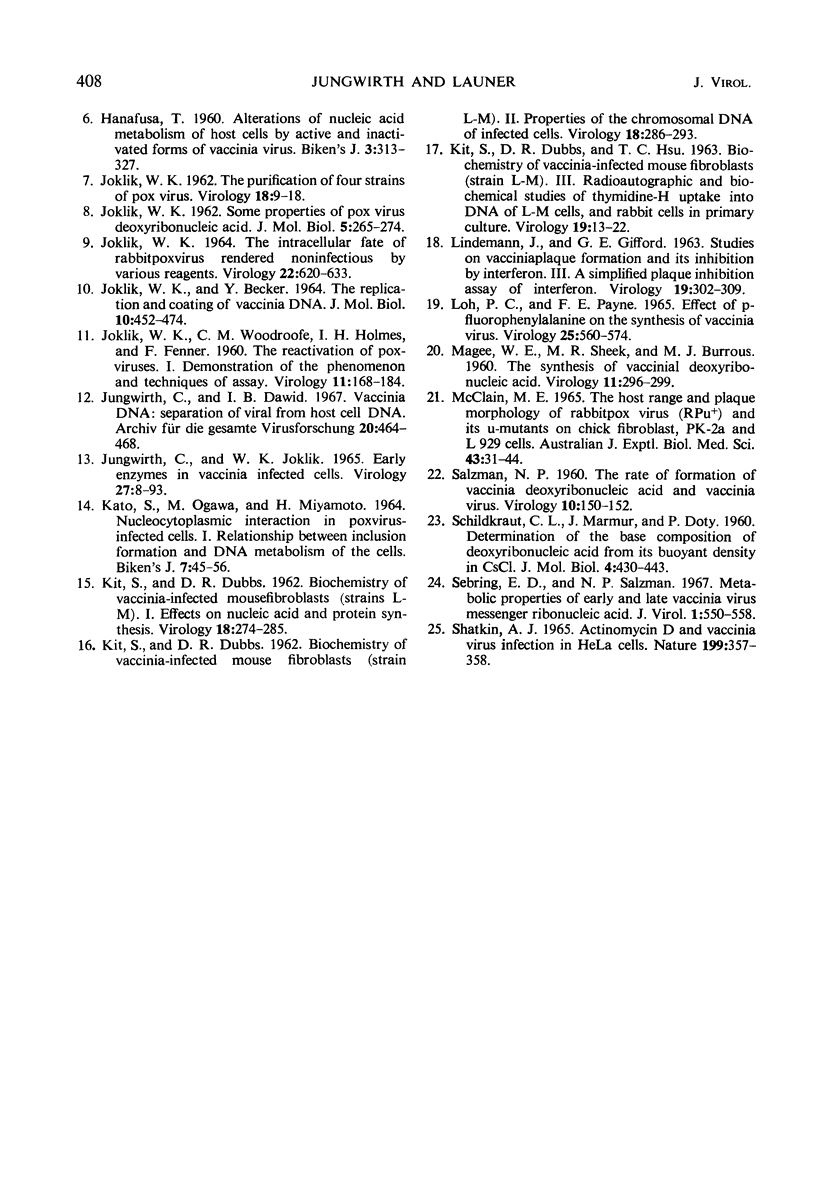
Selected References
These references are in PubMed. This may not be the complete list of references from this article.
- BEN-PORAT T., KAPLAN A. S. MECHANISM OF INHIBITION OF CELLULAR DNA SYNTHESIS BY PSEUDORABIES VIRUS. Virology. 1965 Jan;25:22–29. doi: 10.1016/0042-6822(65)90247-3. [DOI] [PubMed] [Google Scholar]
- CAIRNS J. The initiation of vaccinia infection. Virology. 1960 Jul;11:603–623. doi: 10.1016/0042-6822(60)90103-3. [DOI] [PubMed] [Google Scholar]
- DALES S., KAJIOKA R. THE CYCLE OF MULTIPLICATION OF VACCINIA VIRUS IN EARLE'S STRAIN L CELLS. I. UPTAKE AND PENETRATION. Virology. 1964 Nov;24:278–294. doi: 10.1016/0042-6822(64)90167-9. [DOI] [PubMed] [Google Scholar]
- EAGLE H. Amino acid metabolism in mammalian cell cultures. Science. 1959 Aug 21;130(3373):432–437. doi: 10.1126/science.130.3373.432. [DOI] [PubMed] [Google Scholar]
- Green M. Biosynthetic modifications induced by DNA animal viruses. Annu Rev Microbiol. 1966;20:189–222. doi: 10.1146/annurev.mi.20.100166.001201. [DOI] [PubMed] [Google Scholar]
- JOKLIK W. K., BECKER Y. THE REPLICATION AND COATING OF VACCINIA DNA. J Mol Biol. 1964 Dec;10:452–474. doi: 10.1016/s0022-2836(64)80066-8. [DOI] [PubMed] [Google Scholar]
- JOKLIK W. K. THE INTRACELLULAR FATE OF RABBITPOX VIRUS RENDERED NONINFECTIOUS BY VARIOUS REAGENTS. Virology. 1964 Apr;22:620–633. doi: 10.1016/0042-6822(64)90084-4. [DOI] [PubMed] [Google Scholar]
- JOKLIK W. K. The purification fo four strains of poxvirus. Virology. 1962 Sep;18:9–18. doi: 10.1016/0042-6822(62)90172-1. [DOI] [PubMed] [Google Scholar]
- JOKLIK W. K., WOODROOFE G. M., HOLMES I. H., FENNER F. The reactivation of poxviruses. I. Demonstration of the phenomenon and techniques of assay. Virology. 1960 May;11:168–184. doi: 10.1016/0042-6822(60)90060-x. [DOI] [PubMed] [Google Scholar]
- Jungwirth C., Dawid I. B. Vaccinia DNA: separation of viral from host cell DNA. Arch Gesamte Virusforsch. 1967;20(4):464–468. doi: 10.1007/BF01275228. [DOI] [PubMed] [Google Scholar]
- Jungwirth C., Joklik W. K. Studies on "early" enzymes in HeLa cells infected with vaccinia virus. Virology. 1965 Sep;27(1):80–93. doi: 10.1016/0042-6822(65)90145-5. [DOI] [PubMed] [Google Scholar]
- KATO S., OGAWA M., MIYAMOTO H. NUCLEOCYTOPLASMIC INTERACTION IN POXVIRUS-INFECTED CELLS. I. RELATIONSHIP BETWEEN INCLUSION FORMATION AND DNA METABOLISM OF THE CELLS. Biken J. 1964 Jul;7:45–56. [PubMed] [Google Scholar]
- KIT S., DUBBS D. R. Biochemistry of vaccinia-infected mouse fibroblasts (strain L-M). I. Effects on nucleic acid and protein synthesis. Virology. 1962 Oct;18:274–285. doi: 10.1016/0042-6822(62)90014-4. [DOI] [PubMed] [Google Scholar]
- KIT S., DUBBS D. R. Biochemistry of vaccinia-infected mouse fibroblasts (strain L-M). II. Properties of the chromosomal DNA of infected cells. Virology. 1962 Oct;18:286–293. doi: 10.1016/0042-6822(62)90015-6. [DOI] [PubMed] [Google Scholar]
- KIT S., DUBBS D. R., HSU T. C. Biochemistry of vaccinia-infected mouse fibroblasts (strain L-M). III. Radioautographic and biochemical studies of thymidine-H3 uptake into DNA of L-M cells and rabbit cells in primary culture. Virology. 1963 Jan;19:13–22. doi: 10.1016/0042-6822(63)90019-9. [DOI] [PubMed] [Google Scholar]
- LINDENMANN J., GIFFORD G. E. Studies on vaccinia virus plaque formation and its inhibition by interferon. III. A simplified plaque inhibition assay of interferon. Virology. 1963 Mar;19:302–309. doi: 10.1016/0042-6822(63)90068-0. [DOI] [PubMed] [Google Scholar]
- LOH P. C., PAYNE F. E. EFFECT OF P-FLUOROPHENYLALANINE ON THE SYNTHESIS OF VACCINIA VIRUS. Virology. 1965 Apr;25:560–574. doi: 10.1016/0042-6822(65)90084-x. [DOI] [PubMed] [Google Scholar]
- MAGEE W. E., SHEEK M. R., BURROUS M. J. The synthesis of vaccinial deoxyribonucleic acid. Virology. 1960 May;11:296–299. doi: 10.1016/0042-6822(60)90070-2. [DOI] [PubMed] [Google Scholar]
- MCCLAIN M. E. THE HOST RANGE AND PLAQUE MORPHOLOGY OF RABBITPOX VIRUS (RPU+) AND ITS U MUTANTS ON CHICK FIBROBLAST, PK-2A, AND L929 CELLS. Aust J Exp Biol Med Sci. 1965 Feb;43:31–44. doi: 10.1038/icb.1965.3. [DOI] [PubMed] [Google Scholar]
- SALZMAN N. P. The rate of formation of vaccinia deoxyribonucleic acid and vaccinia virus. Virology. 1960 Jan;10:150–152. doi: 10.1016/0042-6822(60)90015-5. [DOI] [PubMed] [Google Scholar]
- SCHILDKRAUT C. L., MARMUR J., DOTY P. Determination of the base composition of deoxyribonucleic acid from its buoyant density in CsCl. J Mol Biol. 1962 Jun;4:430–443. doi: 10.1016/s0022-2836(62)80100-4. [DOI] [PubMed] [Google Scholar]
- SHATKIN A. J. ACTINOMYCIN D AND VACCINIA VIRUS INFECTION OF HELA CELLS. Nature. 1963 Jul 27;199:357–358. doi: 10.1038/199357a0. [DOI] [PubMed] [Google Scholar]
- Sebring E. D., Salzman N. P. Metabolic properties of early and late vaccinia virus messenger ribonucleic acid. J Virol. 1967 Jun;1(3):550–558. doi: 10.1128/jvi.1.3.550-558.1967. [DOI] [PMC free article] [PubMed] [Google Scholar]


